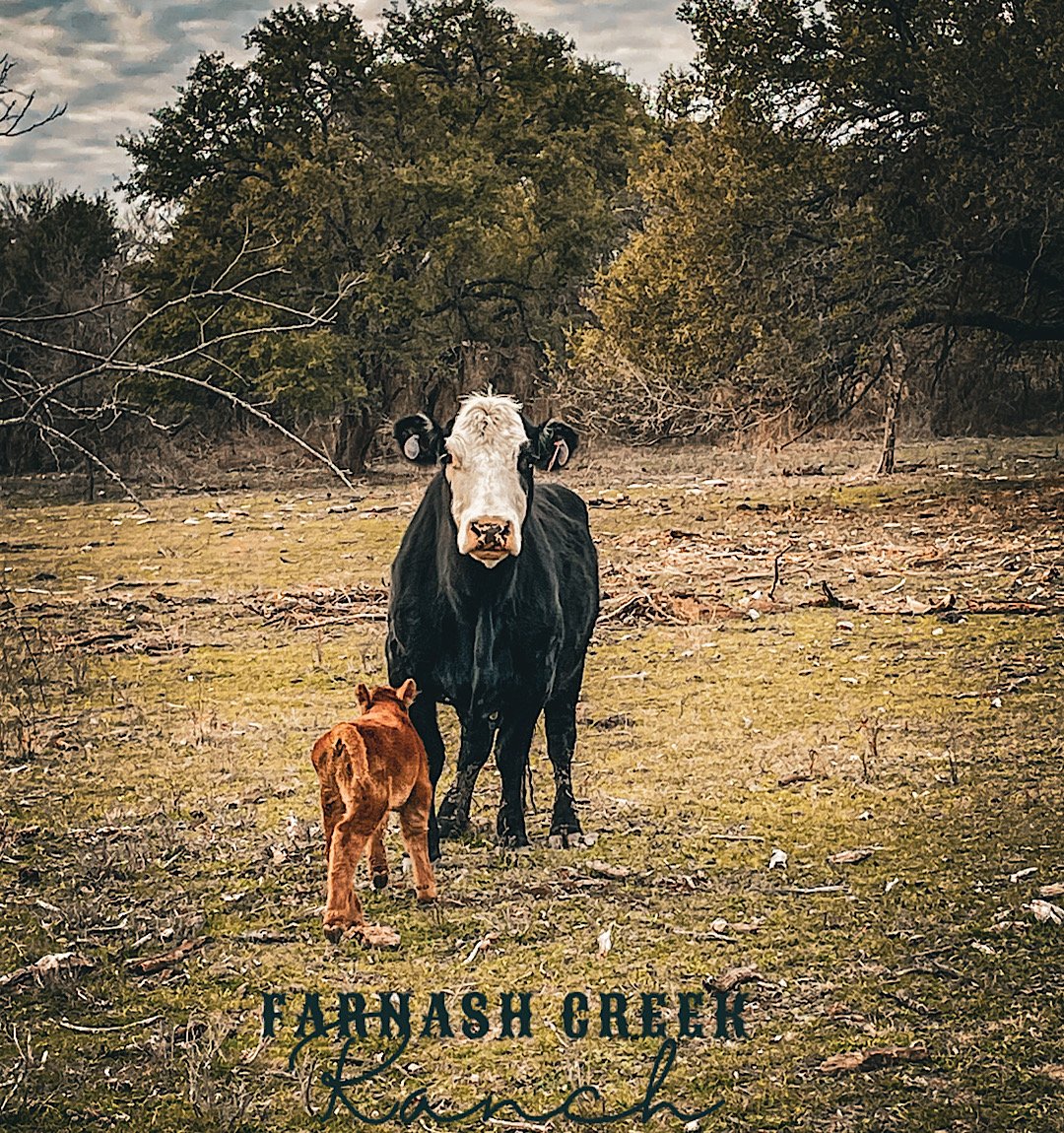Cattle Color Genetics
Last week we had two little red calves!
Commercial Brangus Momma with her new red baby calf!
On the ranch we raise primarily Commercial Brangus dams (not pure bred - predominantly black with occasional white face) with registered Angus sires (solid black). We occasionally buy bred cows for replacement mothers as our cows age out or as we increase our herd size. Granted, we can’t be certain what they are bred with but the assumption is Brangus (Brahaman/Angus X) or Angus sires.
Occasionally, we will get a solid white baby and recently a couple of red babies. How does this happen with a black dam and black sire? Let’s take a closer look at color genetics in cattle.
This is an over simplified explanation of color gene expression in cattle. All cattle get one base color coat trait from the dam and one from the sire. These various color traits are called alleles. There are only three base color coat alleles in cattle: black [ED], red [e] and wild [E+]. Wild [E+] is a combination of red and black pigmentation usually with darker on the extremities and a lighter colored muzzle.
So a calf will get one of these three alleles from the mom and one from dad. The black allele [ED] is always dominant. Meaning if they get this allele they will always be black. Next in dominance, is the wild allele [E+] also called co-dominant. It will be dominant over red but not black. Finally, the red [e] allele is not dominant at all and is considered recessive. Meaning they have to get a red [e] allele from mom and dad to be red. Here are some examples of color combinations and outcomes of offspring:
Black x any color = Black
Wild x Red = Wild
Wild x Wild = Wild
Red X Red = Red
Even though a cow or bull is a certain color does not mean they will pass that color on to offspring. If a calf is black it can have any of the following allele sequences: black x black, black x red, or black x wild. If it has two black alleles it is homozygous black (has two same alleles). In this case, the offspring of this calf will always be black because it only has a black allele to pass on. If it is a black calf with black X red or black X wild (heterozygous black) it can pass on any of the three alleles to offspring either black, red, or wild. This means the offspring will be red, wild or black depending on what allele they get from the other parent.
This means our little red calves got a red allele from both parents. They are homozygous red. All reds are homozygous otherwise they would not express the color red because the red allele is recessive and needs two copies to be present. Angus cattle can also carry a red or black allele and maybe in rare circumstances, wild. In Florida, there have been studies on a herd of white angus. Read about them in this article in Beef Magazine:
https://www.beefmagazine.com/blog/genetic-accident-produces-white-angus
Brangus Mom and baby red!
Now, after the base color there are several other color traits they can inherit from their mom and dad. This includes things like the white face on this mom! She didn’t pass that allele on to her baby apparently! White face can be caused by several different spotting alleles including, but not limited to hereford pattern [SH], blaze [Bl], or piebald [s].
In addition to spotting, there are also other alleles that can be passed on such as dilution alleles that include dun [Dn], charolais [Dc] or roan [R]. The degree of dilution will depend on whether the calf is homozygous or heterozygous. For example, if they get the roan dilution allele from both parents they will be almost completely white and if they only get one, they will be more representative of a true dun color. Dun dilution predominantly dilutes the red pigmentation and to a lesser degree, the black pigment.
There are many other color patterns that are expressed by the presence of different alleles, to include things like brindle color, belting, brockling (color inside of a white spot), etc. Other alleles aside from color that can be passed to offspring include things like temperament, horns, feet, and even marbling at least to some degree.
There are two genetic “types” of cattle: bos indicus and bos tarus. The bos indicus cattle are better adapted to hot climate and the bos tarus are better adapted to cooler conditions. Bos indicus cattle have a hump on their back, large ears and lighter coat colors to help with heat. A familiar breed is the Brahman cattle. The bos tarus have no hump, smaller ears and darker color to help with the cold. A familiar breed is Angus. We have bred indicus and tarus together to make a superior bovine that can hopefully adapt well and produce great beef. They will still carry some of the genes from their ancestors.
Understanding color patterns can help you determine the origins or your cattle and their genetic potential. This will help you to not only gauge their ability to adapt to a given environment, but also their ability to produce great beef.
We are breeding for solid black cattle but I am always so excited when I see some color! We are happy to have the reds! They are both heifers so we will keep them around!

